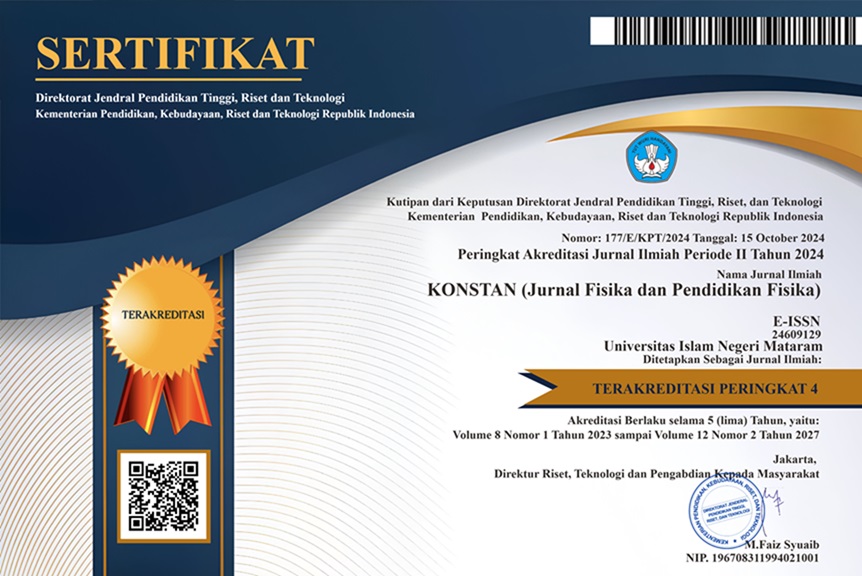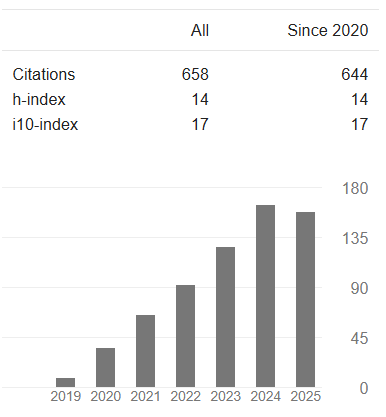Functional Group Analysis of Silica Gel Based on River Sand Magnetic Mineral as Heavy Metal Absorbance
Abstract
Functional group analysis of silica gel synthesized from river sand magnetic minerals using the sol-gel method was conducted. River sand magnetic mineral samples were taken from Sompang River, Lombok. The synthesis method used is a sol-gel method with variation of HCl acid 10 M and NH4OH base 10 M. Morphological characterization using a Scanning Electron Microscope (SEM) and mineral content analysis using Energy Dispersive X-ray (EDX). The morphology of the resulting silica gel is granular, showing crystalline properties with a silica concentration of 77.99 ± 0.17 atomic percent. Silica functional groups before absorption showed three stretching vibrations, namely OH group stretching vibrations in Si-OH and H2O at an absorption wavelength of 3669.77 cm-1, Si-O stretching vibrations from siloxane (Si-O-Si) at an absorption wavelength of 2858.51 cm-1 and Si-O asymmetric stretching vibrations from silanol (Si-OH) at an absorption wavelength of 962.88 cm-1. While the results of the analysis of silica gel after absorption show that almost all samples have vibrational absorption in the range of 400-500 cm-1. Other vibrational absorptions in silica samples that have been used as water filters indicate that the bonding between nano-silica as an absorber and heavy metals is due to the magnetic properties of nano-silica.
Downloads
References
[2] Murraya, N. Taufiq-Spj, and E. Supriyantini, “Content of Heavy Metal Iron (Fe) in Water, Sediment, and Green Shellfish (Perna viridis) in Tanjung Emas Waters, Semarang,” Trop. Mar. J., vol. 18, no. 1, pp. 133–140, 2015.
[3] S. C. S. M. Hemachandra and B. G. N. Sewwandi, “Application of water pollution and heavy metal pollution indices to evaluate the water quality in St. Sebastian Canal, Colombo, Sri Lanka,” Environ. Nanotechnology, Monit. Manag., vol. 20, p. 100790, 2023, doi: 10.1016/j.enmm.2023.100790.
[4] D. Mridul, D. Parashar, M. S. Shuaibu, S. G. Abdullahi, S. Abubakar, and B. B. Bala, “Water pollution: Effects on health and environment of Dala LGA, Nigeria,” Mater. Today Proc., no. xxxx, 2020, doi: 10.1016/j.matpr.2020.10.496.
[5] M. M. M. Syeed, M. S. Hossain, M. R. Karim, M. F. Uddin, M. Hasan, and R. H. Khan, “Surface water quality profiling using the water quality index, pollution index and statistical methods: A critical review,” Environ. Sustain. Indic., vol. 18, p. 100247, 2023, doi: 10.1016/j.indic.2023.100247.
[6] L. Zhu, Z. J. B. M. Husny, N. A. Samsudin, H. Xu, and C. Han, “Deep learning method for minimizing water pollution and air pollution in urban environment,” Urban Clim., vol. 49, p. 101486, 2023, doi: 10.1016/j.uclim.2023.101486.
[7] L. Ho et al., “Impact of salinity gradient, water pollution and land use types on greenhouse gas emissions from an urbanized estuary,” Environ. Pollut., vol. 135, p. 122500, 2023, doi: 10.1016/j.envpol.2023.122500.
[8] M. K. Hasan, A. Shahriar, and K. U. Jim, “Water pollution in Bangladesh and its impact on public health,” Heliyon, vol. 5, no. 8, p. e02145, 2019, doi: 10.1016/j.heliyon.2019.e02145.
[9] A. Syuzita, L. A. D. Meiliyadi, and Bahtiar, “Tingkat Pencemaran Lindi Pada Air Tanah Dangkal Di Sekitar TPA Kebon Kongok Menggunakan Parameter Fisika dan Kimia,” J. Fis. Flux J. Ilm. Fis. FMIPA Univ. Lambung Mangkurat, vol. 19, no. 2, pp. 126–134, 2022, doi: 10.20527/flux.v19i2.13030.
[10] L. A. D. Meiliyadi and A. Syuzita, “Sosialisasi Tingkat Pencemaran Air Sumur Berdasarkan Parameter Fisika di Desa Telagawaru,” J. War. Desa, vol. 4, no. 1, pp. 27–33, 2022, doi: 10.2930/jwd.v4i1.173.
[11] Nurhidayati, L. A. Didik, and A. Zohdi, “Identifikasi Pencemaran Logam Berat di Sekitar Pelabuhan Lembar Menggunakan Analisa Parameter Fisika dan Kimia,” J. Fis. Flux J. Ilm. Fis. FMIPA Univ. Lambung Mangkurat, vol. 18, no. 2, pp. 139–148, 2021, doi: 10.20527/flux.v18i2.9873.
[12] F. Ningsih;, Fitrianingsih;, and L. A. Didik, “Analisis Pengaruh Lama Penggerusan terhadap Resistivitas dan Konstanta Dielektrik pada Pasir Besi yang disintesis dari Kabupaten Bima,” Indones. Phys. Rev., vol. 2, no. 3, pp. 92–98, 2019, doi: 10.29303/ipr.v2i3.31.
[13] J. C. B. Moraes et al., “New use of sugar cane straw ash in alkali-activated materials: A silica source for the preparation of the alkaline activator,” Constr. Build. Mater., vol. 171, no. 5, pp. 611–621, 2018, doi: 10.1016/j.conbuildmat.2018.03.230.
[14] X. Han, J. Liang, S. Fukuda, L. Zhu, and S. Wang, “Sodium alginate–silica composite aerogels from rice husk ash for efficient absorption of organic pollutants,” Biomass and Bioenergy, vol. 159, p. 106424, 2022, doi: 10.1016/j.biombioe.2022.106424.
[15] A. Jyoti, R. K. Singh, N. Kumar, A. K. Aman, and M. Kar, “Synthesis and properties of amorphous nanosilica from rice husk and its composites,” Mater. Sci. Enginering B, vol. 263, p. 114871, 2021, doi: 10.1016/j.mseb.2020.114781.
[16] O. Olawale, “Bamboo leaves as an alternative source for silica in ceramics using Box Benhken design,” Sci. African, vol. 8, p. e00418, 2020, doi: 10.1016/j.sciaf.2020.e00418.
[17] Z. Asadi and R. Norouzbeigi, “Synthesis of colloidal nanosilica from wate glass powder as a low cost precursor,” Ceram. Int., vol. 44, no. 18, 2018, doi: 10.1016/j.ceramint.2018.09.050.
[18] L. A. D. Meiliyadi, M. Wahyudi, I. Damayanti, and A. Fudholi, “Morphological characteristics and electrical properties analysis of silica based on river and coastal iron sand,” J. Ilm. Pendidik. Fis. Al-Biruni, vol. 11, no. 1, pp. 129–140, 2022, doi: 10.24042/jipfalbiruni.v11i1.12390.





